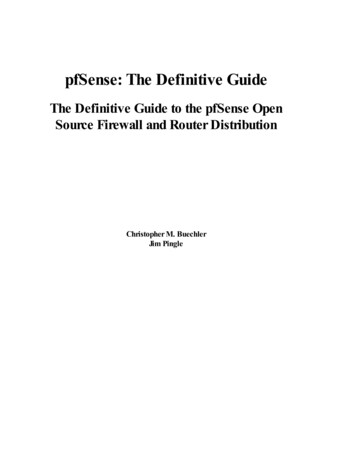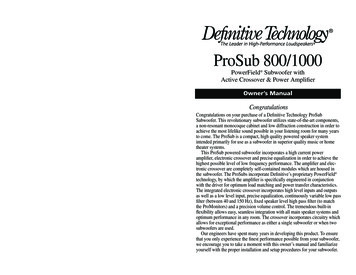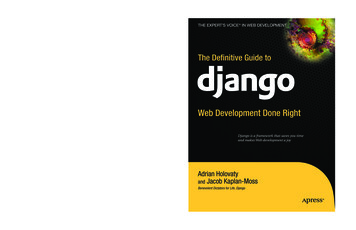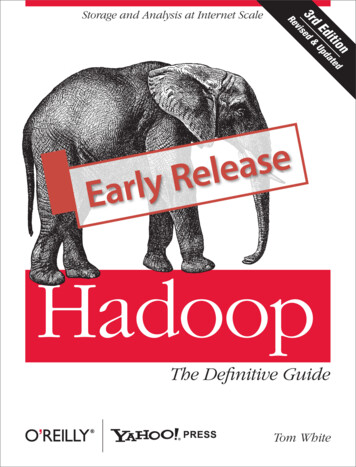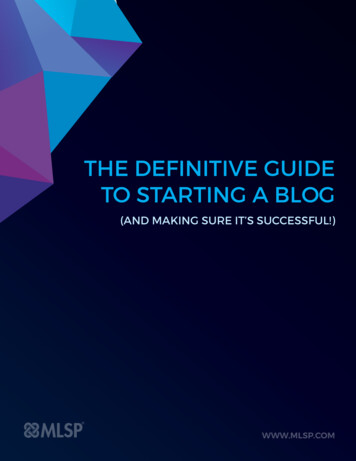
Transcription
THE DEFINITIVE GUIDETO STARTING A BLOG(And Making Sure it’s Successful!)www.mlsp.com
CONTENTS (clickable)The Technical Side of Starting a Blog. . . . . . . . . . . . . . . . . . . . . . . . . . . . . . . 4Choose a Blog Platform . . . . . . . . . . . . . . . . . . . . . . . . . . . . . . . . . . . . . . . . . . . . .4Choose a Hosting Provider . . . . . . . . . . . . . . . . . . . . . . . . . . . . . . . . . . . . . . . . . . .5Choose a Domain Name . . . . . . . . . . . . . . . . . . . . . . . . . . . . . . . . . . . . . . . . . . . . 7Install Wordpress . . . . . . . . . . . . . . . . . . . . . . . . . . . . . . . . . . . . . . . . . . . . . . . . . 8Themes, Plugins, Design & Writing . . . . . . . . . . . . . . . . . . . . . . . . . . . . . . . . . . . . .8Mistakes People Make When Starting a Blog . . . . . . . . . . . . . . . . . . . . . . . . .13Defining Your Target Market . . . . . . . . . . . . . . . . . . . . . . . . . . . . . . . . . . . . . . . . . 14Figuring Out Your Site Structure . . . . . . . . . . . . . . . . . . . . . . . . . . . . . . . . . . . . . . 16Why is Site Structure Important . . . . . . . . . . . . . . . . . . . . . . . . . . . . . . . . . . . . . 17How to Achieve the Ideal Site Structure . . . . . . . . . . . . . . . . . . . . . . . . . . . . . . . 18Wordpress Categories & Tags . . . . . . . . . . . . . . . . . . . . . . . . . . . . . . . . . . . . . . . 20Take Advantage of a Great Site Structure . . . . . . . . . . . . . . . . . . . . . . . . . . . . . . 21Wrapping Up: Steps to Setting Up Your Site Structure . . . . . . . . . . . . . . . . . . . . . 22Basic Keyword Research . . . . . . . . . . . . . . . . . . . . . . . . . . . . . . . . . . . . . . . . 24Why Do At Least Basic Keyword Research . . . . . . . . . . . . . . . . . . . . . . . . . . . . . .24They Keyword Research Terms. . . . . . . . . . . . . . . . . . . . . . . . . . . . . . . . . . . . . . 25Free Keyword Research Tools . . . . . . . . . . . . . . . . . . . . . . . . . . . . . . . . . . . . . . .27www.mlsp.com2
The Definitive Guide toStarting a Blog(And Making Sure it’s Successful!)Thinking about starting a blog? Great! You may belooking for a technical tutorial on how to buy hosting and a domain and get your blog setup. I’m goingto touch on these steps briefly, but setting up a bloghas become extremely easy these days. Especiallywhen compared to even just a few years ago.Many hosting providers offer a one-click setup to geta WordPress blog up and running.(Heck, here at MLSP we offer MLSP Sites, which is a oneclick blog setup providing you with thousands of dollarsworth of premium themes and plugins.)What I really want to cover here though are the 3biggest mistakes that new (or even experienced)bloggers make when starting a blog. If you makewww.mlsp.comthese three mistakes during this startup process, it’sall for nothing. These go way beyond tips on startinga blog, these are flat out necessities. The technicalside of it has become the easy part. THIS is wherethe magic happens.I want to not only discuss these 3 mistakes here butalso give you a roadmap on how to avoid them altogether. This will make your blog stand out from themasses and give your readers the best experiencepossible. More importantly, give them reasonsto keep coming back.First let’s take a look at the technical steps of actually how to start a blog, getting it setup, and creatingyour home on the web.3
The Technical Side ofStarting a BlogI’m going to break this down in to 5 simple steps that you can complete in probably 20 minutes. That way we can get to the important stuff.1.Choose a Blogging Platform2.Choose Your Hosting3.Choose Your Domain Name4.Install WordPress5.Themes, Plugins, Design & Writing1. Choose a Blogging PlatformThis one is easy. In my opinion you don’t really havea choice here. You are going to want to useWordPress, and you want to host it yourself.(Easier than you may think.) What is the differencebetween hosting it yourself and letting WordPresshost it for you?it hosted at WordPress. The issue with this is that itSEVERELY limits you on what you can do. It limitswhich plugins you can use, which themes, and ifyou want to start getting to a professional level ontheir hosting, you will either start paying for moreadvanced features through them or host your blogyourself.Let me clear this up. If you go to wordpress.comright now, you can create a blog for free and havewww.mlsp.com4
Now, if you go to wordpress.org right now, you willsee a button that says ‘download WordPress.’ Basically, in the old days, you would download WordPress and have to go through a bunch of technicalsteps to get it running on your own so that you havecomplete freedom. These days it can be done in oneclick without downloading anything. This is what wemean by a ‘self-hosted blog.’So, step 1 here is easy - you want a self-hostedWordPress blog. Let’s figure out how to do that.2. Choose a HOSTINGPROVIDERA hosting service provides you with server space tohost our blog. It’s basically your blogs home, and aswith any home, you get what you pay for.There are a ton of choices when it comes to choosing a hosting provider. There are some super cheapoptions, some very expensive options and some options who specialize in hosting WordPress sites &blogs.IMPORTANT NOTE: Before we make some recommendations here, I need to point out that, if this isnot the first article you took a look at before starting a blog, you may notice a lot of people promotingwww.mlsp.comBluehost as a great option for hosting. Now, whilethey aren’t necessarily the worst option out there,they are far from the best. (I have some sites personally hosted with Bluehost and I’m moving awayfrom them as soon as I find the time to do so.)The reason why you see them promoted so much isthat they have the best affiliate payout among hosting providers. That means the people that promotethem get paid whenever someone signs up fromtheir recommendation. Hard to give an unbiased review when you get paid to promote a service.Below are some suggestions for hosting your WordPress site. The first 3 typically provide ‘shared hosting’ services, meaning your blog will be sharing aserver with many other sites. This is fine for beginner blogs and some small businesses that don’t expect a lot of traffic.If you plan on relying on your blog for business, youprobably won’t want to go for the cheapest option.Or you may want to look into a ‘managed hosting’service like the last one we talk about here.NOTE: All of these options provide one-click installs ofthe WordPress platform and are great for beginners.Keep in mind if you go for the cheapest plan, as youprogress and build your blog, you will most likely needto upgrade your hosting with these companies or moveelsewhere. All of them have professional level options.5
HOSTING PROVIDER OPTIONSNOTE: MLSP Sites users are provided with enterprise level hosting which provides top notch speed and security. We only host MLSP Sites accounts on ourservers so are able to optimize for WordPress. (Not to mention the thousandsof dollars worth of plugins and themes provided!)SitegroundSiteground has been quickly climbing the ranks when it comes to reliable WordPress hosting.Prices start as low as 3.95 per month for your first year and you also get a free domain namefor one year. One great thing about SiteGround is that they are very honest about what theirplans can handle (which means you aren’t going to be paying for server space you won’t need!)For instance, the cheapest plan works until you’re receiving 10,000 visitors per month, at whichcase you will probably want to upgrade - but if you are getting that much traffic, it’s worth it.InMotionInMotion web hosting is becoming much more popular as well and has tested well in recent webhost comparison tests when it comes to speed. They have WordPress specific options starting ataround 3/month. (NOTE: I WOULD NOT recommend getting the 3/month plan if you plan onusing your blog for your business. For around 8/month with them you can get 4 times the performance with the better server setup they provide. Again, as with pretty much anything, when itcomes to hosting you get what you pay for!)A2 HostingA2 has aslo recently been making a name for themselves when it comes to wordpress hosting.Their claim to fame right now is their speed that can be achieved at their Turbo package. Note,this does not come with their cheapest package, but it’s good to know it’s there should you everwant to upgrade. They have great customer reviews and their customer support seems to betop-notch as well.WP EngineWP Engine is in a different league than the others listed above. It is a managed hosting platformthat ONLY allows WordPress powered sites. That means that their servers are strategically designed to provide the best service possible for WordPress. This is where it comes down to theold adage ‘you get what you pay for,’ as WP Engine plans start at 29/month.www.mlsp.com6
3. Choose a DomainNameThe next thing you’ll want to do is pick a domainname for your site. A domain name is the friendlynaming system for giving addresses to web serversand web pages. In simpler terms, it’s the name youtype into your web browser to go to the websitesyou want. For instance, apple.com or facebook.com.Your domain name should be based on whatyour brand is online. So, if you are branding yourself, you’d use your name. If you have a businessname, you’d want to use that.Also, you want to try your best to get the .com version of your domain name (instead of, say, .net orinfo) as .com addresses have been around the longest. They are pretty much the default when peoplethink of domain names.For example, if my name was Jonathan Snow, and Iwas branding myself online, I’d try to get jonathans-now.com. If that wasn’t available, I’d have to get alittle creative. Perhaps something like jonathansnowonline.com or jonathansnowlive.com. Or go with adifferent extension (like .net or .org) Notice I’m stilltrying to keep my name in the domain, as that iswhat I’m trying to brand online.When purchasing a domain, typically you will be ableto get one for free (at least for the first year) fromyour hosting provider when you purchase hostingfor your site. After that, it’s usually only between 10and 20 A YEAR for the domain.If you aren’t purchasing hosting from anywhere (forexample if you have a blog hosted with MLSP Sitesor WordPress.com) then we recommend you gowith Godaddy. You can get started with a domainthrough them for under 12 for the first year, thenit’s 15 a year after that. The great thing about Godaddy is that they give you access to settings andcustomization that most places don’t let you touchwithout buying full hosting.The most common domain extensions fordomain names are by far .com. So, if possible, try to get the .com version of yourdomain namewww.mlsp.com7
4. Install WordPressLike I said above, gone are the days of having todownload the WordPress platform, connect to aserver via FTP, create a database, upload and connect everything. whew! Every host mentioned hereprovides a one-click install for WordPress.For instance, to set up your WordPress powered siteon Siteground, you simply access your cPanel (settings panel) and scroll down to find the Autoinstall-ers section. There, you just click on WordPress andtheir setup wizard takes you the rest of the way!This is pretty much the same process for any major web host out there today, but if you have anyquestions about your specific host, the four mentioned here have amazing customer service andthey can (and would be happy to) help you get it alltaken care of!Example of a wordpress autoinsaller. Pretty much every good hosting provider has something like this to help you get wordpressinstalled in one click.5. Themes, Plugins,Design & WritingSo you’ve got a blogging platform, a host, a domainand you are ready to rock! Now it’s time to let thecreative side of you shine!One of the many reasons why WordPress is the bestplatform for you to choose from is the extendabilityof it. You literally have thousands and thousands ofdevelopers working on creating plugins and themesfor WordPress so you can accomplish everythingyou want on your site with very little effort! You dothis by choosing a great theme and installing somepowerful plugins.www.mlsp.comThemesThe first thing you are going to want to do is pickout a theme. I HIGHLY recommend you go with apremium theme. These average around 50 eachand are typically either a one time fee or you payannually for ongoing support. The reason why you’dgo premium (rather than a free theme) is that theyare usually always being worked on & improved, andalways have some form of support.PluginsWordPress plugins add functionality to your blog.For instance, you can have a plugin that adds ‘social share’ buttons to your blog, one that allows youto add popup forms, ones that add tracking and somuch more.8
The WordPress pluginrepository right now hasover 49,000 plugins tochoose from! BE CAREFULTHOUGH! Poorly codedplugins are the number 3reason behind WordPresswebsites getting hacked(number 1 is actually having a cheap and vulnerExample of a plugin in the Wordpress plugin repository. Pay attention to reviews,able web host. hint hint).number of installs and ratingsIf you are choosing to gowith free plugins, makecan start with one that needs minimal changes to fitsure they have great reyour needs.views, are updated consistently and are used on avery high number of blogs.Genesis is one of the most well-known and highly recommended WordPress theme companiesFor instance, Akismet (which is an anti-spamaround. It is expertly coded, super lightweight (fast),plugin) is installed on over 3 million blogs, hassecure, reliable and highly extendable.5 stars with great reviews, an active supportforum and was just recently updated. (This is aThis MLSP Blog uses the Genesis Framework.great plugin!)There are literally thousands of options when itcomes to WordPress Themes and Plugins. I’m goingto recommend a few here, but in the end, you needto make the decisions on what to use based on whatYOUR blog is meant to accomplishDiviGenesis FrameworkIf you want to go with something a bit more advanced that comes with a drag-and-drop pagebuilder, then Divi is a good option. It’s developed byElegant Themes and has almost a cult like following.I’ve seen some beautiful sites built on Divi. (I’ve alsoseen some pretty rough ones. Just because you can doso much with Divi, doesn’t mean you should. Remember, keep the end user experience in mind! Do you reallyneed 18 moving objects on your sidebar?)Here at MLSP, we highly recommend the GenesisFramework. It’s basically a two part system. Youhave the main framework that handles all of thefunctionality, and then you choose a ‘child theme’that handles all of the design. This makes is supereasy to change themes, edit styles and redesignyour site without ever having to change (and potentially mess up) the functionality because you neverhave to touch the overall framework. On top of that,there are so many child themes to choose from, youIMPORTANT TIP: Divi uses something called ‘shortcodes’ in order to achieve its page building functionality. They are specific to their theme. This meansthat if you decide to use Divi, and you use their pagebuilder on all of your pages and posts, you are prettymuch locked into using their theme. It will be VERYdifficult and time consuming to change themes. Isthat a terrible thing? No, Divi doesn’t seem to begoing anywhere anytime soon. But you should beaware of it.Recommended Themes:www.mlsp.com9
If none of these fit the bill for you, you can alwaystake a look at themeforest.net. It’s one of the mostpopular WordPress theme repositories around.Again though, just like the WordPress plugins, makesure to do your due diligence before you purchaseyour theme. Check the reviews, look at support, seehow active the community is around it. (Poorly coded themes are actually the number 2 reason sites gethacked!)Recommended PluginsBoth of these plugins offer some amazing features.Popup forms, Exit intent forms (these pop up whenthe reader goes to leave your site), widgets andmore.Click here to check out OptinmonsterUse the coupon code MLSP10 to save 10%!With so many options available, it’s nearly impossible to recommend a plugin for every possible feature you’d want on your blog. I’m going to cover thebasic necessities here.The most important thing to remember when looking for plugins is:Make sure they are secure and well maintained! Plugins cause bloat and can quicklyslow down your site. Is it something you trulyneed?If you have a plugin that you aren’t using or doesn’tprovide value to you or your target market, get ridof it!I’ll split these recommendations up into the functionality you are trying to gain from the plugin.Building Your Mailing ListIf building your mailing list through your blog is a toppriority, then I highly recommend that this is an areawhere you shell out a little money for a premium plugin. They may cost, but the return on investment willbe well worth it. In this field, there are 2 huge players.Optinmonster and Sumo.www.mlsp.comClick here to check out SumoWhat really makes these plugins powerful thoughare the targeting capabilities. Remember, congruency is key when you are trying to get someone’s emailaddress. You can show different forms based on thecontent the reader is consuming, where they camefrom, if they’ve been to your blog before, and more.There are so many options and it’s so easy to usethat within just a short period of time, you could beusing your blog to collect emails like a seasoned pro.NOTE: If you choose to go with Divi, then you will alsohave access to their list building plugin called Bloom.It’s missing some of the features that I feel are superimportant (being able to redirect the user after they optin for one) but it’s still a great plugin.10
Social Sharing & FollowingAnother action you want your readers to take is toshare your content and potentially find and followyou on your social media accounts. There are a tonof plugins out there that can help you with that.Example of Genesis Simple Share social sharing buttonsIf you use Genesis, they have some of the easiest plugins you can add that are specific to their framework.Genesis Simple Share puts share buttons on yourposts in just a couple of clicks. Simple Social Icons allows you to put links to your social media accounts onyour blog with really nice looking icons very quickly.These are both super simple and super lightweight.If you are using Divi, you also have access to theirsharing/following plugin Monarch. Monarch allowsyou to do the same things Simple Share and SimpleSocial Icons does, but you have a lot more options.They also allow you to connect to your social mediaaccounts via API so that you can show people howmany followers you have already. (Very cool if youhave a pretty large audience). While they have somegreat training to set this plugin up, There is sometechnical setup, just be forewarned.Again, there are a ton of plugins that will get youthis functionality. Just keep the plugin do’s & don’tsin mind when choosing one.Combat COMMENT SpamComment spam is one of the biggestheadaches for blog owners. Whilethere is no way to 100% stop comment spam, there are some pluginsthat do an amazing job to keep you fromhaving to worry about it.Akismet is a plugin from Automatic (the wordpressguys). It is one of the most popular plugins for WordPress, and for good reason. There is a free option,but if you want to donate a little bit, they’d be happyto take your money.WP SpamShield is another great option. This plugin isextremely simple to use. Just install it andactivate it and you’re good to go!SecurityWordPress sites get hacked all the time. With WordPress running over 25% of the websites online today,it’s a huge target. While there is no way to completelylockdown your site, there are definitely steps you cantake to harden your site, and a great security plugincan go a long way.Wordfence is my personal favorite here. They havea free option, but again if your blog is a big part ofyour business, it may be worth putting some moneydown to get the premium version. It has a great firewall, is updated continuously as new threats emerge,scans your site daily for malware, has login security,brute force lockdowns and more. I can’t recommendthese guys enough.Another great option is Sucuri. They too have a freeand premium option. They are a bit more expensivethan Wordfence, but they are a very popular andreputable option when it comes to site security.Other Must Have PluginsJetpack: I am a huge fan of this plugin suite. It’s really like 40 plugins in one. You activate it and justturn on the modules you want to use. They havesocial sharing, widget visibility (we’ll talk more aboutthis), more widgets, shortcode embeds, databasebackups - I can’t list them all here. It requires a freeWordPress.com account, but it’s well worth the timeit takes to get this plugin setup.11
SEO: Yoast SEO - this is the industry standard whenit comes to getting your blog optimized for searchengines.Tracking: If you are building a blog, you should betracking who’s coming to your blog. Google Analyticsis the best way to do this. There are a lot of optionsout there. There are free and premium options herelike Google Analytics , MonsterInsights and GoogleAnalytics Dashboard. Find the one you like best!This pretty much takes care of the technical side ofsetting up your blog. (NOTE that if you are an MLSPSites user, we have either provided access to allof these plugins & themes or taken care of theirfunctionality for you!)Now let’s get in to the important stuff! The next partof this article can make or break your blog. Theseblogging tips can make the difference between asuccessful blog, and a blog nobody every sees! Let’sget started.As you build your blog, plugins will come and go. Remember, only install what you absolutely need in order to keep your blog running quickly and smoothly!www.mlsp.com12
The 3 most common mistakespeople make when startinga blog:Look, starting a blog is a crucial part of any business,especially when you are practicing Attraction Marketing. It gives you a hub, or a home base to addvalue to your target market, build a brand, and buildan audience.There are literally thousands of tutorials around thatwill walk you through how to get a blog set up fromscratch in about 20 minutes.While there are a ton of tutorials out on how tophysically get a blog up and running, the topics covered here are largely overlooked as a whole, whichcauses all sorts for issues in the long run.You see, because it has gotten so easy to set up ablog and start writing, MOST people don’t put anythought in to PREPARING to start writing. THIS iswhere this information will be priceless for you.www.mlsp.comThese are the 3 most commonmistakes people make whenstarting a blog:1.Not Defining Your Target Market2.Not Figuring Out Your Site Structure3.Not Doing Basic Keyword ResearchThroughout this post you will see snippets fromsome training I did at a recent MLSP VIP Workshop. (I smuggled the video out. shhh) I encourage you to watch those if you want togo deeper in to what we are covering here.13
NOTE: This article assumes that you are (or will be) using WordPress as your blogging platform. The screenshots, videos, and walkthroughs covered here are around the WordPressplatform, which we can not recommend enough.Defining Your Target MarketIf I were to breakdown this process in to it’s simplest form, it would be this: Figure out whoyou want to server, and then figure outhow you can serve them. Once you do this,everything else falls in line. Before you begin anytype of content creation, marketing, or monetization strategy, you have to know who you aretalking to!If you come from a place of service to your community & target market, then every piece of content you create will naturally be created out of aneed to help that community. Your content willbe created in order to solve your target market’sbiggest challenges, concerns and problems.A lot of people getting started don’t define theirtarget market at all, and when you visit the blogof this type of person, you will notice isntantly. Blog posts are all over the place, covering arange of topics that don’t relate to one anotherand clearly were not created based on a needto help a specific group of people.Let’s say you decide that your target market ispeople who love camping, and you want to beable to help them get the best gear for cheap,find the best camp sites, travel the country andexperience the lifestyle of a ‘digital nomad,’ andyou are able to monetize this buiseness throughaffiliate marketing. Now let’s imagine that youget a member of this target market to visit yourblog, and the very first article they see is aboutwhy your local steakhouse serves the best ribeye. Hmm. do you think that reader is goingto stick around when they came to your site forwww.mlsp.comcamping tips? Probably not. Do you think they’llever come back?This is probably an extreme example, but you’dbe surprised. and this is what we want to avoid.In order to avoid this, you need to become veryclear about who your target market is. The firststep in figuring this out is to answer the following questions:1.Who are you?2.What do you stand for?3.Who do you serve?4.How can you serve them?The first two questions up there are extremely important. You need to figure out what you are passionate about. What’s life all about for you? What doyou like to talk about? What are your values? What’simportant to you? If you don’t base your blog aroundsomething you are passionate about, you will loseinterest quickly.Once you pinpoint who your target market is, then it’stime to figure out what their biggest challenges, concerns, and problems are. What do they REALLY want?There are some great resources that you can tapin to to dive into your target market’s biggest questions and concerns. You want to do some researchhere and make sure that you KNOW this information, and you are not just assuming you know it.Here are some great options:14
RESOURCES TO DEFINE YOURTARTET MARKETSocial MediaUse Facebook and Twitter and look at hashtags that may be associated with yourmarket. What are they talking about? What words are they using? What questions arethey using? Are there any Facebook groups based around your target market that youcan join?RedditReddit is an online community that provides ‘sub-reddits’ or small communities of specific interests. There is a sub-reddit for pretty much every topic. Find your relevant community on thereand join the discussion!Question & Answer sitesQuestion and answer sites like Quora, or Yahoo Answers can give you great insite into the actual questions your target market is asking when searching in Google (or anysearch engine) - Find out from their mouths (or fingers.) what their most pressingquestions are.AnswerThePublic.comThis is an awesome resource that provides you with questions that your target market is asking in Google and Bing. This is such a great service that, while it’s free now, it probably won’t besoon. It even allows you to export the information they give you in a very nice visual data sheet!These are just some examples, but bottom line is: Find out where your targetmarket hangs out online, and join the conversation!www.mlsp.com15
You should also think about who else is in thespace. Who is the ‘top dog’ so to speak. If YOUwanted to find out these answers where wouldyou go? Find out how THEY are serving the market (and maybe find out how you can do it better).BONUS VIDEOBelow is a snippet of a presentation from thelatest MLSP Training Webinar covering ‘defining your target market’ (Note: MLSP members, you can find the full video in yourmembers area)Once you nail down your target market, it’s time tofigure out what you are going to be talking about,what topics you are going to be covering, the typeof content you are going to be creating, and howyou are going to organize it on your blog. We do thisthrough a combination of creating an organized sitestructure and doing some keyword research. Let’sstart with the site structure.Figuring Out Your Site StructureLet me start here by saying that a site structure isreally just how you are going to organize the contenton your blog.starting to replace ‘Search Engine Optimization’ to‘Search EXPERIENCE Optimization’ because of thefactors that Google uses to rank websites thesedays.A site structure for your blog is extremely important,not only for the search engines (SEO) but also forthe user experience.When we talk about site structure, we are talking about the way your content is organized.Your site is only as goodas the experience it givesusers.From categories, to tags, to pages and posts - everything should be created and organized with PURPOSE, and to provide VALUE to your target market.(Save the ‘what I ate for breakfast this morning’ postfor twitter).In my mind, there is nothing more importantfor any blog than providing a great user experience. So much so, that some SEO pros are nowwww.mlsp.com16
Why is a site structureimportant?Let me give you a real worldexample of what you want t
a WordPress blog up and running. (Heck, here at MLSP we offer MLSP Sites, which is a one click blog setup providing you with thousands of dollars worth of premium themes and plugins.) What I really want to cover here though are the 3 biggest mistakes that new (or even experienced) bloggers make when starting a blog. If you make


